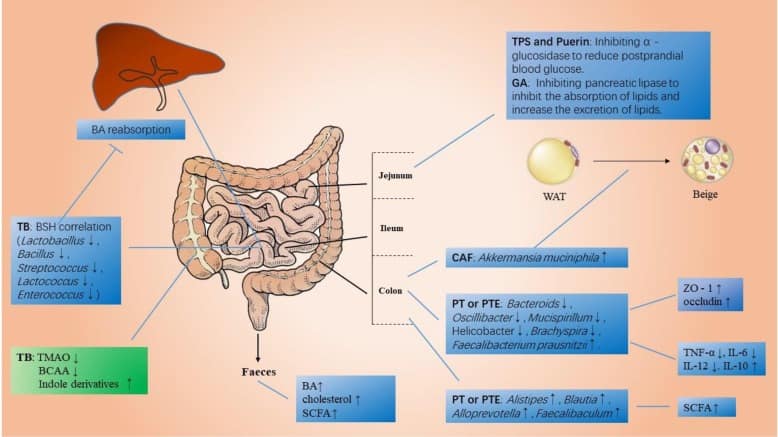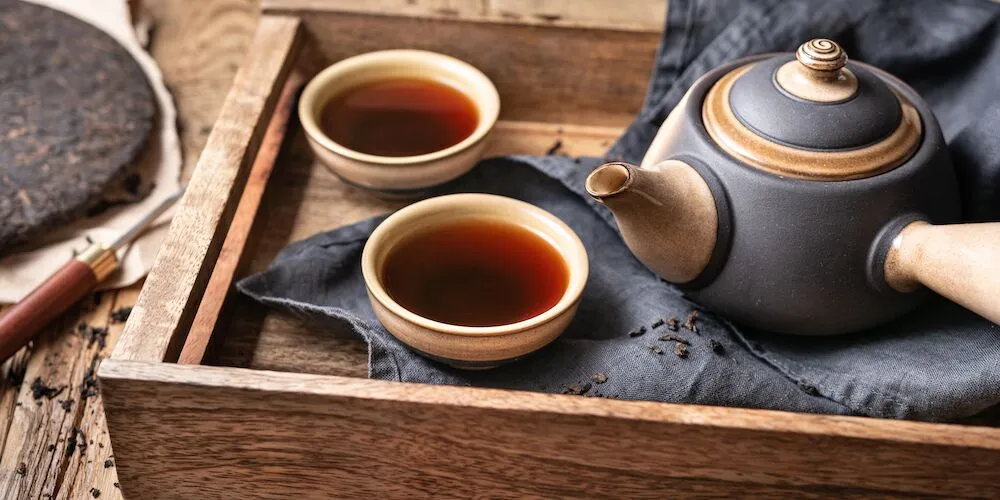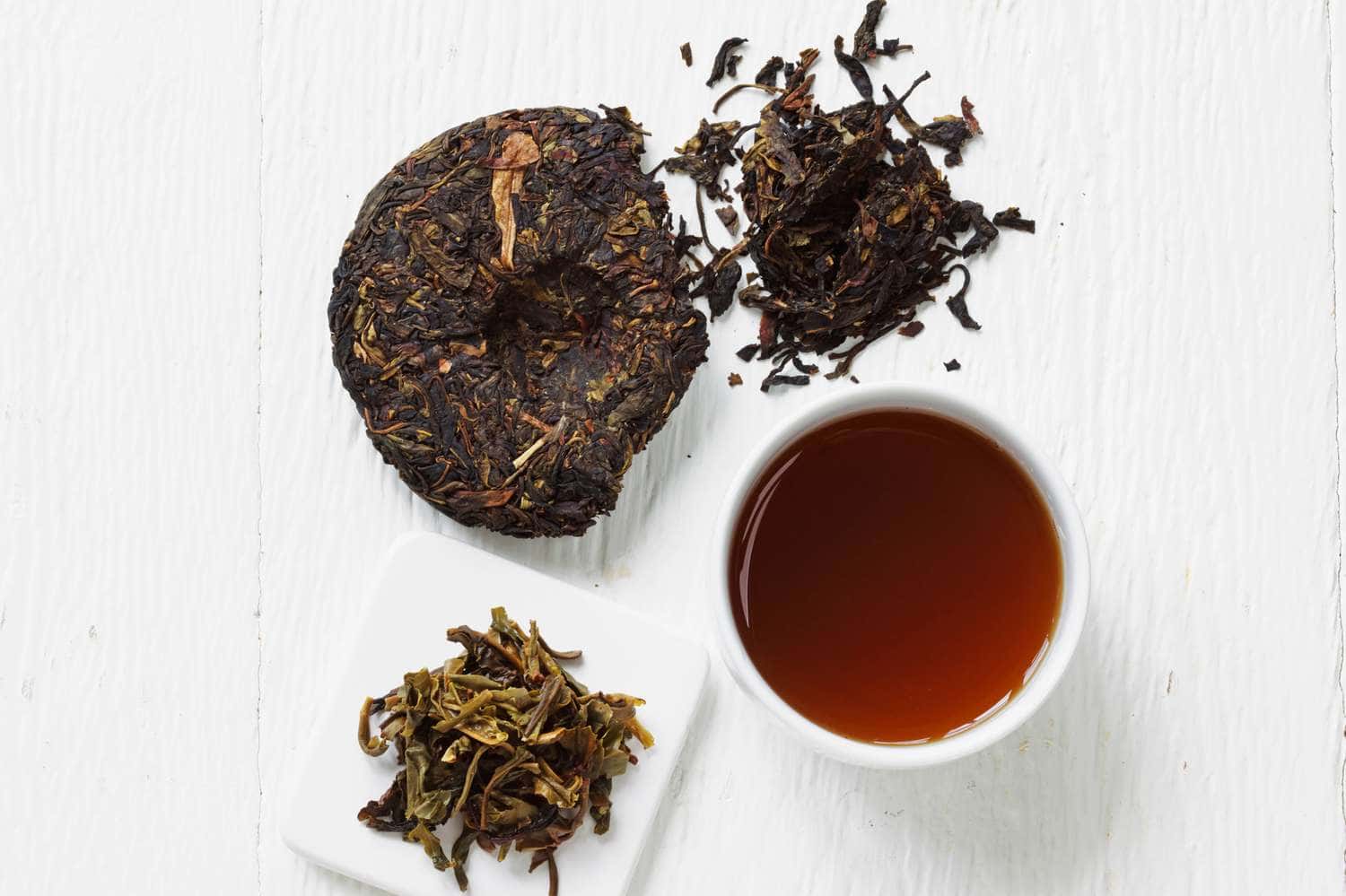Pu-erh tea may support gut health by promoting the growth of beneficial gut bacteria, aiding digestion, and potentially reducing inflammation in the digestive tract.
Sipping Your Way to a Healthy Gut: The Truth About Pu-erh Tea
Tea has long been celebrated for its numerous health benefits, and one area where it particularly shines is gut health. A healthy gut is essential for overall well-being, as it plays a crucial role in digestion, nutrient absorption, and immune function. One type of tea that has gained popularity for its gut-healing properties is Pu-erh tea.
In this article, we will explore what Pu-erh tea is, why it is good for your gut, its history and origins, what makes it unique among other teas, the science behind its gut-healing properties, the benefits of drinking Pu-erh tea for digestive health, ….
What is Pu-erh Tea and Why is it Good for Your Gut?
Pu-erh tea is a type of fermented tea that originates from the Yunnan province in China. It is made from the leaves of the Camellia sinensis plant, the same plant that is used to make green tea and black tea. However, what sets Pu-erh tea apart is its unique fermentation process.
During fermentation, the leaves undergo microbial fermentation and oxidation. This process gives Pu-erh tea its distinct flavor profile and also contributes to its gut-healing properties. The fermentation process produces beneficial bacteria and enzymes that can help promote a healthy balance of gut flora.
The beneficial bacteria in Pu-erh tea can help improve digestion by breaking down food more efficiently and aiding in nutrient absorption. Additionally, these bacteria can help strengthen the gut lining, reducing the risk of leaky gut syndrome and other digestive issues. The enzymes in Pu-erh tea can also help break down complex carbohydrates, making them easier to digest and reducing the likelihood of bloating and gas.
The History and Origins of Pu-erh Tea: A Brief Overview
Pu-erh tea has a rich history that dates back thousands of years. It is believed to have originated in the Yunnan province in China, where it was first cultivated and consumed by the local population.
The exact origins of Pu-erh tea are shrouded in mystery, but it is believed that it was first discovered during the Tang Dynasty (618-907 AD). It was initially consumed for its medicinal properties and was highly prized by emperors and nobles.
Over time, Pu-erh tea gained popularity among the general population and became a staple in Chinese tea culture. It was often used as a digestive aid after meals and was believed to have numerous health benefits.
In recent years, Pu-erh tea has gained international recognition for its unique flavor profile and health benefits. It is now enjoyed by tea enthusiasts around the world.
What Makes Pu-erh Tea Unique Among Other Teas?
While all teas come from the same plant, Pu-erh tea stands out for its unique fermentation process. This fermentation process gives Pu-erh tea its distinct flavor profile and also contributes to its gut-healing properties.
Unlike other teas, which are typically consumed shortly after they are harvested and processed, Pu-erh tea undergoes a secondary fermentation process. This secondary fermentation can last anywhere from a few months to several years, depending on the desired flavor profile.
During fermentation, beneficial bacteria and enzymes are produced, which contribute to the unique flavor and aroma of Pu-erh tea. This fermentation process also results in the formation of bioactive compounds, such as polyphenols and antioxidants, which have been shown to have numerous health benefits.
The Science Behind Pu-erh Tea’s Gut-Healing Properties
The gut-healing properties of Pu-erh tea have been the subject of scientific research, and several studies have shed light on the mechanisms behind its beneficial effects.
One study published in the Journal of Agricultural and Food Chemistry found that Pu-erh tea contains high levels of polyphenols, which are known for their antioxidant and anti-inflammatory properties. These polyphenols can help reduce inflammation in the gut and promote the growth of beneficial bacteria.
Another study published in the Journal of Functional Foods found that Pu-erh tea contains a unique type of polyphenol called theabrownins. These theabrownins have been shown to have antimicrobial properties, which can help maintain a healthy balance of gut flora.
Furthermore, Pu-erh tea has been found to contain high levels of catechins, which are a type of antioxidant that has been shown to have anti-inflammatory and immune-boosting properties. These catechins can help protect the gut lining from damage and reduce the risk of digestive issues.
The Benefits of Drinking Pu-erh Tea for Digestive Health
Drinking Pu-erh tea can offer numerous benefits for digestive health. Here are some of the ways that Pu-erh tea can help promote a healthy gut:
1. Improved digestion: The beneficial bacteria and enzymes in Pu-erh tea can help improve digestion by breaking down food more efficiently and aiding in nutrient absorption. This can help reduce the risk of digestive issues such as bloating, gas, and constipation.
2. Reduced inflammation: The polyphenols in Pu-erh tea have been shown to have anti-inflammatory properties. By reducing inflammation in the gut, Pu-erh tea can help alleviate symptoms of inflammatory bowel diseases such as Crohn’s disease and ulcerative colitis.
3. Enhanced gut flora: The fermentation process of Pu-erh tea produces beneficial bacteria that can help promote a healthy balance of gut flora. This can help strengthen the gut lining, reduce the risk of leaky gut syndrome, and improve overall gut health.
4. Antimicrobial properties: The theabrownins in Pu-erh tea have been shown to have antimicrobial properties, which can help maintain a healthy balance of gut flora and reduce the risk of harmful bacterial overgrowth.
5. Weight management: Pu-erh tea has been found to have potential weight loss properties. It can help boost metabolism, increase fat oxidation, and suppress appetite, making it a valuable tool for weight management.
How Pu-erh Tea Can Improve Your Immune System and Overall Wellness
In addition to its gut-healing properties, Pu-erh tea can also improve your immune system and overall wellness. Here are some of the ways that Pu-erh tea can benefit your immune system:
1. Antioxidant activity: Pu-erh tea is rich in antioxidants, which can help protect the body against oxidative stress and free radicals. This can help strengthen the immune system and reduce the risk of chronic diseases.
2. Anti-inflammatory properties: The polyphenols in Pu-erh tea have been shown to have anti-inflammatory properties. By reducing inflammation in the body, Pu-erh tea can help support a healthy immune response.
3. Antimicrobial activity: The theabrownins in Pu-erh tea have been found to have antimicrobial properties, which can help fight off harmful bacteria and viruses.
4. Stress reduction: Pu-erh tea contains an amino acid called L-theanine, which has been shown to have calming effects on the brain. By reducing stress and promoting relaxation, Pu-erh tea can help support a healthy immune system.
5. Detoxification: Pu-erh tea has been traditionally used in Chinese medicine for its detoxifying properties. It can help support liver function and aid in the elimination of toxins from the body, which can have a positive impact on overall wellness.
The Role of Pu-erh Tea in Weight Loss and Management
Pu-erh tea has gained popularity as a weight loss aid, and several studies have explored its potential effects on weight management. Here are some of the ways that Pu-erh tea can aid in weight loss and management:
1. Increased fat oxidation: Pu-erh tea has been found to increase fat oxidation, which is the process by which the body breaks down stored fat for energy. By increasing fat oxidation, Pu-erh tea can help promote weight loss.
2. Boosted metabolism: Pu-erh tea has been shown to increase metabolism, which is the rate at which the body burns calories. By boosting metabolism, Pu-erh tea can help support weight loss and prevent weight gain.
3. Appetite suppression: Pu-erh tea has been found to suppress appetite, making it easier to stick to a calorie-controlled diet. By reducing cravings and promoting feelings of fullness, Pu-erh tea can help support weight management.
4. Reduced fat absorption: Some studies have suggested that Pu-erh tea may inhibit the absorption of dietary fat. By reducing fat absorption, Pu-erh tea can help prevent weight gain and promote weight loss.
5. Blood sugar regulation: Pu-erh tea has been found to have potential effects on blood sugar regulation. By stabilizing blood sugar levels, Pu-erh tea can help prevent spikes and crashes in energy levels, which can contribute to overeating and weight gain.
How to Brew the Perfect Cup of Pu-erh Tea for Maximum Health Benefits
To brew the perfect cup of Pu-erh tea and maximize its health benefits, follow these steps:
1. Start with high-quality Pu-erh tea: Choose a high-quality Pu-erh tea from a reputable source. Look for loose leaf tea rather than tea bags, as loose leaf tea tends to have better flavor and aroma.
2. Measure the right amount of tea: Use about 1 teaspoon of Pu-erh tea leaves per cup of water. Adjust the amount according to your taste preferences.
3. Preheat your teapot or teacup: Rinse your teapot or teacup with hot water to preheat it. This will help maintain the temperature of the water during brewing.
4. Heat the water: Bring fresh, filtered water to a boil. The ideal temperature for brewing Pu-erh tea is around 195°F (90°C).
5. Rinse the tea leaves: Pour a small amount of hot water over the Pu-erh tea leaves to rinse them. This helps remove any dust or impurities and prepares the leaves for brewing.
6. Steep the tea: Pour the hot water over the rinsed tea leaves and let them steep for about 2-3 minutes. Adjust the steeping time according to your taste preferences.
7. Strain and serve: After steeping, strain the tea leaves and pour the brewed Pu-erh tea into your teacup. You can enjoy it plain or add honey or lemon for added flavor.
The Different Types of Pu-erh Tea and Their Unique Flavors and Characteristics
Pu-erh tea comes in different types, each with its own unique flavors and characteristics. Here are some of the most common types of Pu-erh tea:
1. Raw Pu-erh (Sheng Pu-erh): Raw Pu-erh is made from leaves that are sun-dried and then aged naturally. It has a light, floral flavor and a slightly bitter taste. Raw Pu-erh is known for its ability to age and develop complex flavors over time.
2. Ripe Pu-erh (Shou Pu-erh): Ripe Pu-erh is made from leaves that undergo an accelerated fermentation process. This process results in a dark, earthy flavor and a smooth, mellow taste. Ripe Pu-erh is often preferred by those who enjoy a stronger, more robust flavor.
3. Aged Pu-erh: Aged Pu-erh refers to Pu-erh tea that has been stored for an extended period, usually several years or more. Aged Pu-erh develops rich, complex flavors and aromas, with notes of earthiness, woodiness, and sometimes even hints of fruit or flowers.
4. Loose Leaf Pu-erh: Loose leaf Pu-erh refers to Pu-erh tea that is sold in loose leaf form, rather than in tea bags. Loose leaf Pu-erh tends to have better flavor and aroma compared to tea bags, as the leaves have more room to expand during brewing.
5. Tuocha Pu-erh: Tuocha Pu-erh refers to Pu-erh tea that is compressed into small, bowl-shaped cakes or nests. These cakes are convenient for brewing and can be easily broken apart for individual servings.
Each type of Pu-erh tea offers a unique flavor profile and aroma, so it’s worth exploring different varieties to find the one that suits your taste preferences.
The Potential Side Effects of Drinking Pu-erh Tea and How to Avoid Them
While Pu-erh tea is generally safe for most people to consume, it can cause side effects in some individuals. Here are some potential side effects of drinking Pu-erh tea and tips for avoiding them:
1. Caffeine sensitivity: Pu-erh tea contains caffeine, which can cause side effects such as jitteriness, anxiety, and insomnia in individuals who are sensitive to caffeine. If you are sensitive to caffeine, it’s best to limit your intake of Pu-erh tea or opt for decaffeinated varieties.
2. Stomach upset: Some individuals may experience stomach upset or digestive issues after consuming Pu-erh tea. This can be due to the fermentation process or the presence of tannins in the tea. If you experience stomach upset, try reducing your intake or switching to a different type of tea.
3. Interactions with medications: Pu-erh tea may interact with certain medications, including blood thinners and medications for high blood pressure. If you are taking any medications, it’s best to consult with your healthcare provider before adding Pu-erh tea to your routine.
4. Allergic reactions: In rare cases, individuals may experience allergic reactions to Pu-erh tea. If you have a known allergy to tea or any of its components, it’s best to avoid Pu-erh tea.
To minimize the risk of side effects, it’s important to consume Pu-erh tea in moderation and listen to your body’s response. If you experience any adverse effects, it’s best to discontinue use and consult with a healthcare professional.
Where to Buy Pu-erh Tea and Tips for Choosing a Pu-erh Tea
When it comes to buying Pu-erh tea, there are a few options available. One can purchase it from specialty tea shops, online retailers, or even directly from tea producers in regions like Yunnan, China, where Pu-erh tea is traditionally grown.
However, it is essential to be cautious and ensure the authenticity and quality of the tea before making a purchase. Here are some tips for choosing a high-quality Pu-erh tea:
1. Research reputable sellers: Look for well-established tea shops or online retailers with positive customer reviews and a reputation for selling authentic Pu-erh tea. This will help ensure that you are purchasing from a reliable source.
2. Check the origin: Authentic Pu-erh tea comes from Yunnan province in China. Look for teas that specify their origin and avoid those with vague or misleading information.
3. Determine the type: Pu-erh tea can be classified into two main types: raw (sheng) and ripe (shou). Raw Pu-erh is typically aged for a longer time and has a more complex flavor profile, while ripe Pu-erh undergoes an accelerated fermentation process resulting in a smoother taste. Consider your preference and choose accordingly.
4. Look for certifications: Some Pu-erh teas may have certifications like Organic or Fair Trade, indicating that they meet specific quality standards. These certifications can provide additional assurance of the tea’s quality and ethical sourcing.
5. Consider the age: Pu-erh tea can be aged for several years or even decades, resulting in different flavors and characteristics. Younger Pu-erh teas tend to have a more vibrant taste, while older ones develop deeper and mellower flavors. Decide whether you prefer a younger or aged Pu-erh tea based on your taste preferences.
6. Sample before buying: If possible, try to sample different Pu-erh teas before making a purchase. This will allow you to experience the flavors and determine which ones you enjoy the most.
By following these tips, you can ensure that you are purchasing high-quality Pu-erh tea that meets your preferences and provides an authentic tea-drinking experience.
Originally posted 2024-02-25 12:01:48.




